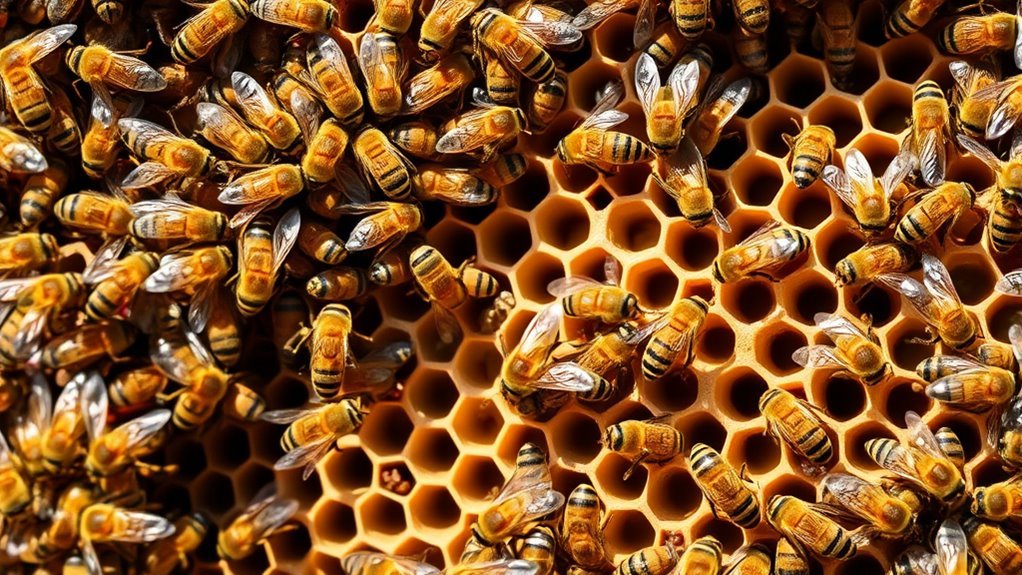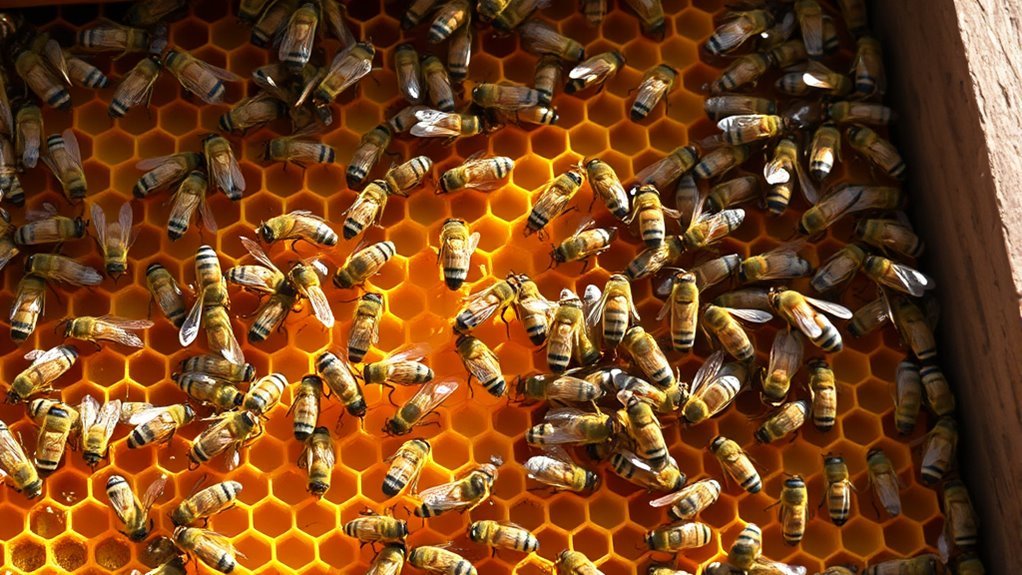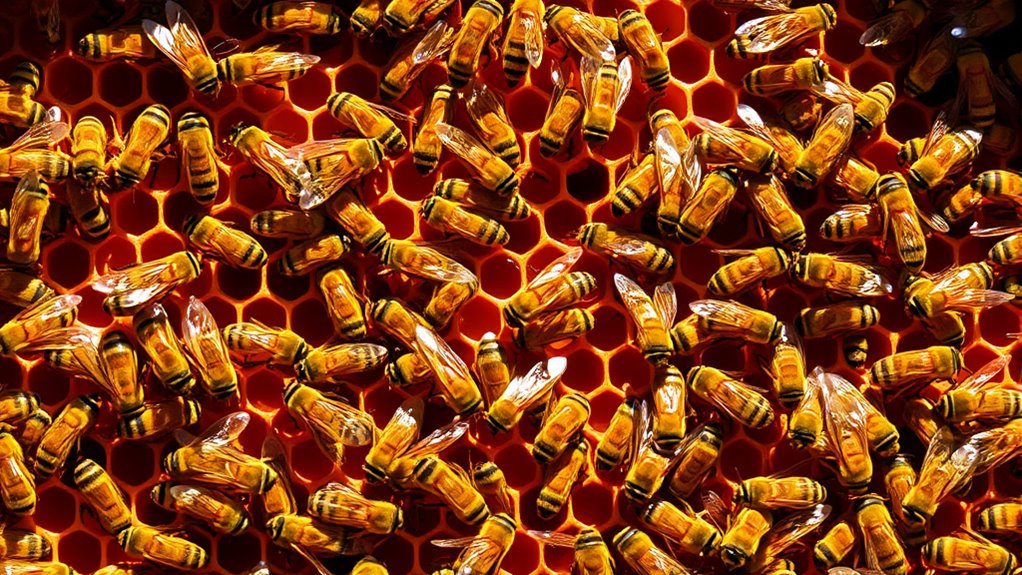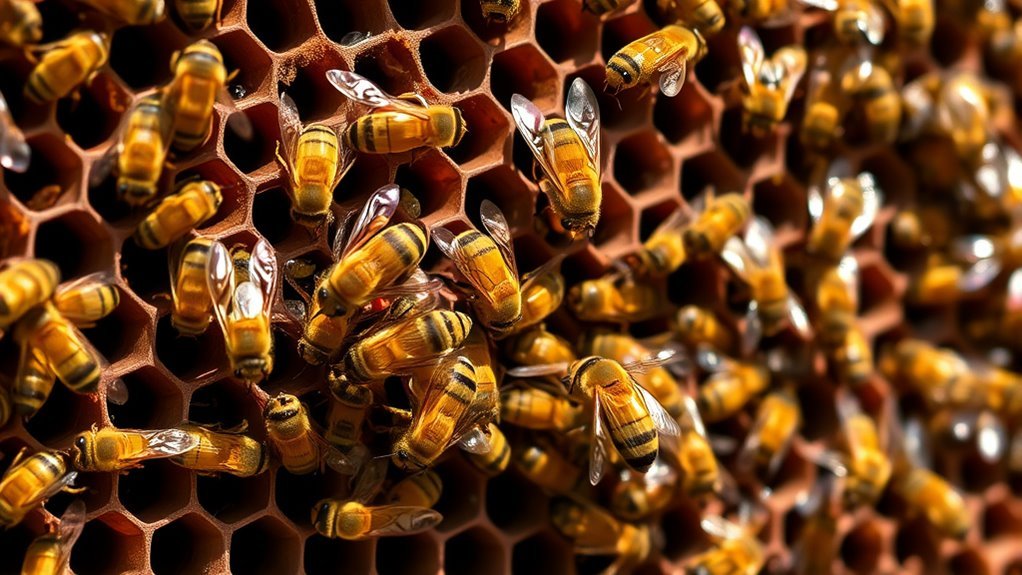You’ll typically find several hundred drone bees in a healthy hive during peak breeding season, as their main role is to mate with queens and guarantee genetic diversity. Their numbers vary with environmental conditions, food availability, and colony health, increasing in spring and early summer and dropping sharply in autumn. Too many drones can strain resources, while too few limit reproduction success. Understanding how drones affect hive dynamics can provide deeper insights into colony health and sustainability.
Role of Drone Bees in the Colony

Although drone bees don’t gather nectar or pollen like worker bees, their primary role in the colony is vital for reproduction. You should understand that drone reproduction involves mating with a queen from another hive during her nuptial flight, ensuring genetic diversity and colony survival. Drone behavior is distinct from other bees; they do not participate in hive maintenance or defense. Instead, their energy is devoted to developing flight muscles and reproductive organs necessary for successful mating. While drones rely on workers for feeding and care, their presence is significant during the breeding season. Recognizing the specific function of drones helps you appreciate the balance between freedom and purpose within the hive’s complex social structure, where each member’s role supports the colony’s long-term resilience and adaptability.
Typical Number of Drones in a Healthy Hive

A healthy hive typically contains several hundred drones during the peak breeding season, though this number can fluctuate based on environmental conditions and colony health. These drones are essential for drone mating, ensuring genetic diversity by fertilizing queens from different colonies. You’ll notice that drone population influences hive dynamics, affecting resource allocation and colony behavior. While drones do not gather food or participate in typical worker tasks, their presence is critical during reproductive periods. The hive balances maintaining enough drones for successful mating flights without overcommitting resources, which could strain the colony. Understanding the typical number of drones helps you appreciate how hives optimize reproductive success while maintaining overall colony stability. This balance reflects the hive’s adaptive strategies to sustain freedom in its reproductive processes.
Factors Influencing Drone Population

When environmental factors such as temperature, food availability, and seasonal changes shift, you’ll notice significant effects on the drone population within a hive. Drone genetics play an essential role in determining the resilience and reproductive success of drones. Environmental factors directly influence drone survival rates and development. Understanding these variables can help you predict fluctuations in drone numbers.
| Factor | Impact on Drone Population |
|---|---|
| Temperature | Affects drone metabolism and activity |
| Food Availability | Limits or supports drone development |
| Drone Genetics | Determines fitness and mating success |
| Hive Health Status | Influences drone rearing and longevity |
Seasonal Changes in Drone Numbers
Understanding how factors like temperature and food availability impact drone populations sets the stage for examining how these influences vary throughout the year. You’ll notice that drone production experiences marked seasonal fluctuations, typically increasing during spring and early summer when conditions favor mating flights. As resources become abundant, the colony invests more energy in producing drones to maximize reproductive opportunities. Conversely, as autumn approaches and temperatures decline, drone numbers decrease sharply. This reduction aligns with dwindling food supplies and the colony’s strategic shift to conserve energy for winter survival. By tracking these seasonal fluctuations, you can better appreciate the dynamic balance within a hive, where environmental cues drive reproductive strategies and resource allocation, ultimately shaping the number of drones present at any given time.
Impact of Drone Population on Hive Health
Although drones primarily exist to mate with queens, their population size directly influences hive health by affecting resource allocation and colony dynamics. When you monitor drone numbers, you’ll see that excessive drones can strain food stores, as they consume resources without contributing to foraging or hive maintenance. Conversely, too few drones limit genetic diversity, which is essential for resilient drone genetics and overall colony fitness. Maintaining an ideal drone population guarantees balanced hive dynamics, promoting effective reproduction and disease resistance. You must recognize that the queen’s mating success depends on a diverse pool of drones, so managing drone numbers impacts long-term hive viability. Understanding these relationships allows you to support a robust, adaptable colony while preserving the freedom of natural hive processes.

